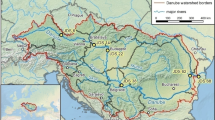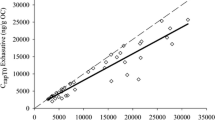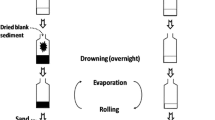Abstract
Matrix solid phase microextraction (matrix-SPME) was evaluated as a surrogate for the absorbed dose in organisms to estimate bioavailability and toxicity of permethrin and dichlorodiphenyltrichloroethane (DDT) in laboratory-spiked sediment. Sediments were incubated for 7, 28, and 90 days at room temperature to characterize the effect of aging on bioavailability and toxicity. Sediment toxicity was assessed using two freshwater invertebrates, the midge Chironomus dilutus and amphipod Hyalella azteca. Disposable polydimethylsiloxane fibers were used to estimate the absorbed dose in organisms and to examine bioavailability and toxicity. The equilibrium fiber concentrations substantially decreased with an increase in sediment aging time, indicating a reduction in bioavailability. Based on median lethal fiber concentrations (fiber LC50), toxicity of permethrin was not significantly different among the different aging times. Due to the substantial degradation of DDT to dichlorodiphenyldichloroethane (DDD) in sediment, sediment toxicity to C. dilutus increased, while it decreased for H. azteca with extended aging times. A toxic unit-based fiber LC50 value represented the DDT mixture (DDT and DDD) toxicity for both species. Significant linear relationships were found between organism body residues and the equilibrium fiber concentrations for each compound, across aging times. The study suggested that the matrix-SPME fibers mimicked bioaccumulation in the organisms, and enabled estimation of body residues, and could potentially be used in environmental risk assessment across matrices (e.g. sediment and water) to measure bioavailability and toxicity of hydrophobic pesticides.




Similar content being viewed by others
References
Abbott WS (1925) A method of computing the effectiveness of an insecticide. J Econ Entomol 18:265–267
Alexander M (2000) Aging, bioavailability, and overestimation of risk from environmental pollutants. Environ Sci Technol 34:4259–4265
Amweg EL, Weston DP, Ureda NM (2005) Use and toxicity of pyrethroid pesticides in the central valley, California, USA. Environ Toxicol Chem 24:966–972
Anderson J, Birge W, Gentile J, Lake J, Rodgers J, Swartz RC (1987) Biological effects, bioaccumulation and ecotoxicology of sediment-associated chemicals. In: Dickson KL, Maki AW, Brungs WA (eds) Fate and effects of sediment-bound chemicals in aquatic systems. Pergamon Press, Elmsford, pp 267–296
Bruijn DJ, Busser F, Seinen W, Hermens J (1989) Determination of octanol/water partition coefficients for hydrophobic organic chemicals with the “slow-stirring” method. Environ Toxicol Chem 8:499–512
Canton JH, Adema DMM (1978) Reproducibility of short term and reproduction toxicity experiments with Daphnia magna and comparison of the sensitivity of Daphnia magna with Daphnia pulex and Daphnia cucullata in short term experiments. Hydrobiologia 59:135–140
Conder JM, Lotufo GR, Bowen AT, Turner PK, La Point TW, Steevens JA (2004) Solid phase microextraction fibers for estimating the toxicity of nitroaromatic compounds. Aquat Ecosys Health Manag 7:387–397
Ding Y, Harwood AD, Foslund HM, Lydy MJ (2010) Distribution and toxicity of sediment-associated pesticides in urban and agricultural waterways from Illinois, USA. Environ Toxicol Chem 29:149–157
Ding Y, Landrum PF, You J, Harwood AD, Lydy MJ (2012a) Use of solid phase microextraction to estimate toxicity: I relating fiber concentrations to toxicity. Environ Toxicol Chem 31(9):2159–2167
Ding Y, Landrum PF, You J, Harwood AD, Lydy MJ (2012b) Use of solid phase microextraction to estimate toxicity: II relating fiber concentrations to body residues. Environ Toxicol Chem 31(9):2168–2174
Ehlers GAC, Loibner AP (2006) Linking organic pollutant (bio)availability with geosorbent properties and biomimetic methodology: a review of geosorbent characterization and (bio)availability prediction. Environ Pollut 141:494–512
Folch J, Lees M, Stanley GHS (1957) A simple method for the isolation and purification of total lipids from animal tissues. J Bio Chem 226:497–509
Forstner U (1987) Sediment-associated contaminants: an overview of scientific bases for developing remedial options. Hydrobiology 149:221–246
Harwood AD, You J, Lydy MJ (2009) Temperature as a toxicity identification evaluation tool for pyrethroid insecticides: toxicokinetic confirmation. Environ Toxicol Chem 28:1051–1058
Hoke RA (1997) Equilibrium partitioning as the basis for an integrated laboratory and field assessment of the impacts of DDT, DDE and DDD in sediments. Ecotoxicology 6:101–125
Hunter W, Xu Y, Spurlock F, Gan J (2008) Using disposable polydimethylsiloxane fibers to assess the bioavailability of permethrin in sediment. Environ Toxicol Chem 27:568–575
Kraaij R, Mayer P, Busser FJM, van het Bolscher M, Seinen W, Tolls J, Belfroid A (2003) Measured pore water concentrations make equilibrium partitioning work—a data analysis. Environ Sci Technol 37:268–274
Landrum PF (1989) Bioavailability and toxicokinetics of polycyclic aromatic hydrocarbons sorbed to sediments for the amphipod Pontoporeia hoyi. Environ Sci Technol 23:588–595
Landrum PF, Robbins JA (1990) Bioavailability of sediment-associated contaminants to benthic invertebrates in sediments: chemistry and toxicity of in-place pollutants. CRC Press, Boca Raton, pp 237–263
Landrum PF, Robinson SD, Gossiaux DC, You J, Lydy MJ, Mitra S, Hulscher T (2007) Predicting bioavailability of sediment-associated organic contaminants for Diporeia spp. and Oligochaetes. Environ Sci Technol 41:6442–6447
Leslie HA, Kraak M, Hermens JLM (2004) Chronic toxicity and body residues of the non-polar narcotic 1,2,3,4-tetrachlorobenzene in Chironomus riparius. Environ Toxicol Chem 23:2022–2028
Lotufo GR, Landrum PF, Gedeon ML, Tigue EA, Herche LR (2000) Comparative toxicity and toxicokinetics of DDT and its major metabolites in freshwater amphipods. Environ Toxicol Chem 19:368–379
Lotufo GR, Landrum PF, Gedeon ML (2001a) Toxicity and bioaccumulation of DDT in freshwater amphipods in exposures to spiked sediments. Environ Toxicol Chem 20:810–825
Lotufo GR, Farrar JD, Duke BM, Bridges TS (2001b) DDT toxicity and critical body residue in the amphipod Leptocheirus plumulosus in exposures to spiked sediment. Arch Environ Contam Toxicol 41:142–150
Maruya KA, Landrum PF, Burgess RM, Shine JP (2012) Incorporating contaminant bioavailability into sediment quality assessment frameworks. Integr Environ Assess Manag 8:659–673
Mayer P, Vaes W, Wijnker F, Legierse K, Kraaij R, Tolls J, Hermens JLM (2000) Sensing dissolved sediment porewater concentrations of persistent and bioaccumulative pollutants using disposable solid-phase microextraction fibers. Environ Sci Technol 34:5177–5183
Mehler WT, Li H, Pang J, Sun B, Lydy MJ, You J (2011) Bioavailability of hydrophobic organic contaminants in sediment with different particle size distributions. Arch Environ Contam Toxicol 61:74–82
Nebeker AV, Shuytema GS, Griffis WL, Barbitter JA, Carey LA (1986) Effect of sediment organic carbon on survival of Hyalella azteca exposed to DDT and endrin. Environ Toxicol Chem 8:705–718
Pehkonen S, You J, Akkanen J, Kukkonen JVK, Lydy MJ (2010) Influence of black carbon and chemical planarity on bioavailability of sediment-associated contaminants. Environ Toxicol Chem 29:1976–1983
Phipps GL, Mattson VR, Ankley GT (1995) Relative sensitivity of three freshwater benthic macroinvertebrates to 10 contaminants. Arch Environ Contam Toxicol 28:281–286
Reid BJ, Jones KC, Semple KT (2000) Bioavailability of persistent organic pollutants in soils and sediments—a perspective on mechanisms, consequences and assessment. Environ Pollut 108:103–112
Trimble AJ (2009) Determining the occurrence, fate, and effects of pesticide mixtures using the aquatic amphipod Hyalella azteca. Dissertation, Southern Illinois University Carbondale
U.S. Environmental Protection Agency (2000) Methods for measuring the toxicity and bioaccumulation of sediment-associated contaminants with freshwater invertebrates, 2nd ed, EPA 600/R-99/064. Office of Research and Development, Duluth
van der Wal L, Jager T, Fleuren RHL, Barendregt A, Sinnige TL, van Gestel CAM, Hermens JLM (2004) Soild-phase microextraction to predict bioavailaibility of organic micropollutants in terrestrial organisms after exposure to a field-contaminated soil. Environ Sci Technol 38:4842-4848
van Handel E (1985) Rapid determination of total lipid in mosquitoes. J Am Mosq Control Assoc 1:302–304
Weston DP, You J, Lydy MJ (2004) Distribution and toxicity of sediment-associated pesticides in agriculture-dominated water bodies of California’s Central Valley. Environ Sci Technol 38:2752–2759
Xu Y, Spurlock F, Wang Z, Gan J (2007) Comparison of five methods for measuring sediment toxicity of hydrophobic contaminants. Environ Sci Technol 41:8394–8399
You J, Lydy MJ, Landrum PF (2006) Comparison of chemical approaches for assessing bioavailability of sediment-associated contaminants. Environ Sci Technol 40:6348–6353
You J, Pehkonen S, Landrum PF, Lydy MJ (2007) Desorption of hydrophobic compounds from laboratory-spiked sediments measured by Tenax absorbent and matrix-solid phase microextraction. Environ Sci Technol 41:5672–5678
You J, Brennan AA, Lydy MJ (2009) Bioavailability and biotransformation of sediment-associated pyrethroid insecticides in Lumbriculus variegatus. Chemosphere 75:1477–1482
Acknowledgments
Yuping Ding was supported by a SIUC 2010-2011 Dissertation Research Assistantship Award. Jing You was financially supported by “the Hundred Talents Program” of the Chinese Academy of Sciences (kzcx2-yw-BR-05). We would like to thank E. Mackenbach for her work culturing C. dilutus and H. azteca.
Declaration
The experiments comply with the current laws of the country in which they were performed.
Conflict of interest
The authors declare that they have no conflict of interests with this research.
Author information
Authors and Affiliations
Corresponding authors
Electronic supplementary material
Below is the link to the electronic supplementary material.
Rights and permissions
About this article
Cite this article
Ding, Y., Landrum, P.F., You, J. et al. Assessing bioavailability and toxicity of permethrin and DDT in sediment using matrix solid phase microextraction. Ecotoxicology 22, 109–117 (2013). https://doi.org/10.1007/s10646-012-1007-z
Accepted:
Published:
Issue Date:
DOI: https://doi.org/10.1007/s10646-012-1007-z




